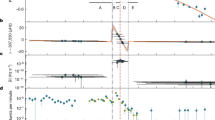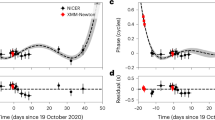Abstract
The 2016 Vela glitch observed by the Mount Pleasant radio telescope provides the first opportunity to study pulse-to-pulse dynamics of a pulsar glitch, opening up new possibilities to study the neutron star’s interior. We fit models of the star’s rotation frequency to the pulsar data, and present the following three results. First, we constrain the glitch rise time to less than 12.6 s with 90% confidence, almost three-times shorter than the previous best constraint. Second, we find definitive evidence for a rotational-frequency overshoot and fast relaxation following the glitch. Third, we find evidence for a slowdown of the star’s rotation immediately before the glitch. The overshoot is predicted theoretically by some models; we discuss implications of the glitch rise and overshoot decay times on internal neutron-star physics. The slowdown preceding the glitch is unexpected; we propose the slowdown may trigger the glitch by causing a critical lag between crustal superfluid and the crust.
This is a preview of subscription content, access via your institution
Access options
Access Nature and 54 other Nature Portfolio journals
Get Nature+, our best-value online-access subscription
$29.99 / 30 days
cancel any time
Subscribe to this journal
Receive 12 digital issues and online access to articles
$119.00 per year
only $9.92 per issue
Buy this article
- Purchase on Springer Link
- Instant access to full article PDF
Prices may be subject to local taxes which are calculated during checkout





Similar content being viewed by others
Data availability
The data used in this work are available from ref. 2.
Code availability
The bilby19 analysis code is available from https://git.ligo.org/lscsoft/bilby and particular scripts for this analysis are available on request from the authors.
References
Anderson, P. W. & Itoh, N. Pulsar glitches and restlessness as a hard superfluidity phenomenon. Nature 256, 25–27 (1975).
Palfreyman, J., Dickey, J. M., Hotan, A., Ellingsen, S. & van Straten, W. Alteration of the magnetosphere of the Vela pulsar during a glitch. Nature 556, 219–222 (2018).
Dodson, R. G., McCulloch, P. M. & Lewis, D. R. High time resolution observations of the January 2000 glitch in the Vela pulsar. Astrophys. J. Lett. 564, L85–L88 (2002).
Dodson, R., Lewis, D. & McCulloch, P. Two decades of pulsar timing of Vela. Astrophys. Space Sci. 308, 585–589 (2007).
van Eysden, C. A. & Melatos, A. Pulsar glitch recovery and the superfluidity coefficients of bulk nuclear matter. Mon. Not. R. Astron. Soc. 409, 1253–1268 (2010).
Haskell, B., Pizzochero, P. M. & Sidery, T. Modelling pulsar glitches with realistic pinning forces: a hydrodynamical approach. Mon. Not. R. Astron. Soc. 420, 658–671 (2012).
Antonelli, M. & Pizzochero, P. M. Axially symmetric equations for differential pulsar rotation with superfluid entrainment. Mon. Not. R. Astron. Soc. 464, 721–733 (2017).
Graber, V., Cumming, A. & Andersson, N. Glitch rises as a test for rapid superfluid coupling in neutron stars. Astrophys. J. 865, 23 (2018).
Ruderman, M. Crust-breaking by neutron superfluids and the Vela pulsar glitches. Astrophys. J. 203, 213–222 (1976).
Cheng, K. S., Alpar, M. A., Pines, D. & Shaham, J. Spontaneous superfluid unpinning and the inhomogeneous distribution of vortex lines in neutron stars. Astrophys. J. 330, 835–846 (1988).
Alpar, M. A., Chau, H. F., Cheng, K. S. & Pines, D. Postglitch relaxation of the Crab pulsar: evidence for crust cracking. Astrophys. J. 427, L29 (1994).
Andersson, N., Comer, G. L. & Prix, R. Are pulsar glitches triggered by a superfluid two-stream instability? Phys. Rev. Lett. 90, 091101 (2003).
Glampedakis, K. & Andersson, N. Hydrodynamical trigger mechanism for pulsar glitches. Phys. Rev. Lett. 102, 141101 (2009).
Peralta, C., Melatos, A., Giacobello, M. & Ooi, A. Transitions between turbulent and laminar superfluid vorticity states in the outer core of a neutron star. Astrophys. J. 651, 1079–1091 (2006).
Warszawski, L. & Melatos, A. Knock-on processes in superfluid vortex avalanches and pulsar glitch statistics. Mon. Not. R. Astron. Soc. 428, 1911–1926 (2013).
Andersson, N., Glampedakis, K. & Hogg, M. Superfluid instability of r-modes in ‘differentially rotating’ neutron stars. Phys. Rev. D 87, 063007 (2013).
Hobbs, G. B., Edwards, R. T. & Manchester, R. N. TEMPO2, a new pulsar-timing package—I. An overview. Mon. Not. R. Astron. Soc. 369, 655–672 (2006).
Edwards, R. T., Hobbs, G. B. & Manchester, R. N. TEMPO2, a new pulsar timing package—II. The timing model and precision estimates. Mon. Not. R. Astron. Soc. 372, 1549–1574 (2006).
Ashton, G. et al. BILBY: a user-friendly Bayesian inference library for gravitational-wave astronomy. Astron. Astrophys. J. Suppl. Ser. 241, 27 (2019).
Buchner, J. et al. X-ray spectral modelling of the AGN obscuring region in the CDFS: Bayesian model selection and catalogue. Astron. Astrophys. 564, A125 (2014).
Feroz, F. & Hobson, M. P. Multimodal nested sampling: an efficient and robust alternative to Markov chain Monte Carlo methods for astronomical data analyses. Mon. Not. R. Astron. Soc. 384, 449–463 (2008).
Feroz, F., Hobson, M. P. & Bridges, M. MULTINEST: an efficient and robust Bayesian inference tool for cosmology and particle physics. Mon. Not. R. Astron. Soc. 398, 1601–1614 (2009).
Sidery, T., Passamonti, A. & Andersson, N. The dynamics of pulsar glitches: contrasting phenomenology with numerical evolutions. Mon. Not. R. Astron. Soc. 405, 1061–1074 (2010).
Alpar, M. A., Langer, S. A. & Sauls, J. A. Rapid postglitch spin-up of the superfluid core in pulsars. Astrophys. J. 282, 533–541 (1984).
Mendell, G. Superfluid hydrodynamics in rotating neutron stars. I—nondissipative equations. II—dissipative effects. Astrophys. J. 380, 515–540 (1991).
Andersson, N., Sidery, T. & Comer, G. L. Mutual friction in superfluid neutron stars. Mon. Not. R. Astron. Soc. 368, 162–170 (2006).
Kass, R. & Raftery, A. Bayes factors. J. Am. Stat. Assoc. 90, 773–795 (2015).
Cordes, J. M. & Shannon, R. M. A measurement model for precision pulsar timing. Preprint at https://arxiv.org/abs/1010.3785 (2010).
Dib, R., Kaspi, V. M. & Gavriil, F. P. Glitches in anomalous X-ray pulsars. Astrophys. J. 673, 1044–1061 (2008).
Weltevrede, P., Johnston, S. & Espinoza, C. M. The glitch-induced identity changes of PSR J1119-6127. Mon. Not. R. Astron. Soc. 411, 1917–1934 (2011).
Archibald, R. F., Kaspi, V. M., Tendulkar, S. P. & Scholz, P. A magnetar-like outburst from a high-B radio pulsar. Astrophys. J. 829, L21 (2016).
Alpar, M. A., Anderson, P. W., Pines, D. & Shaham, J. Giant glitches and pinned vorticity in the Vela and other pulsars. Astrophys. J. 249, L29–L33 (1981).
Link, B. K. & Epstein, R. I. Mechanics and energetics of vortex unpinning in neutron stars. Astrophys. J. 373, 592 (1991).
Pizzochero, P. M. Angular momentum transfer in Vela-like pulsar glitches. Astrophys. J. 743, L20 (2011).
Melatos, A., Peralta, C. & Wyithe, J. S. B. Avalanche dynamics of radio pulsar glitches. Astrophys. J. 672, 1103–1118 (2008).
Fuentes, J. R. et al. The glitch activity of neutron stars. Astron. Astrophys. 608, A131 (2017).
Howitt, G., Melatos, A. & Delaigle, A. Nonparametric estimation of the size and waiting time distributions of pulsar glitches. Astrophys. J. 867, 60 (2018).
Acknowledgements
We are grateful to A. Melatos and I. Jones for valuable comments. Computations were performed on the OzStar supercomputer. P.D.L. is supported through an Australian Research Council Future Fellowship FT160100112 and Discovery Project DP180103155. V.G. is supported by a McGill Space Institute postdoctoral fellowship and the Trottier Chair in Astrophysics and Cosmology.
Author information
Authors and Affiliations
Contributions
G.A. was responsible for the data analysis. G.A., P.D.L. and V.G. were responsible for the model development and discussion. J.P. was responsible for the data collection and reduction.
Corresponding author
Ethics declarations
Competing interests
The authors declare no competing interests.
Additional information
Publisher’s note: Springer Nature remains neutral with regard to jurisdictional claims in published maps and institutional affiliations.
Rights and permissions
About this article
Cite this article
Ashton, G., Lasky, P.D., Graber, V. et al. Rotational evolution of the Vela pulsar during the 2016 glitch. Nat Astron 3, 1143–1148 (2019). https://doi.org/10.1038/s41550-019-0844-6
Received:
Accepted:
Published:
Issue Date:
DOI: https://doi.org/10.1038/s41550-019-0844-6
This article is cited by
-
Searches for continuous-wave gravitational radiation
Living Reviews in Relativity (2023)



